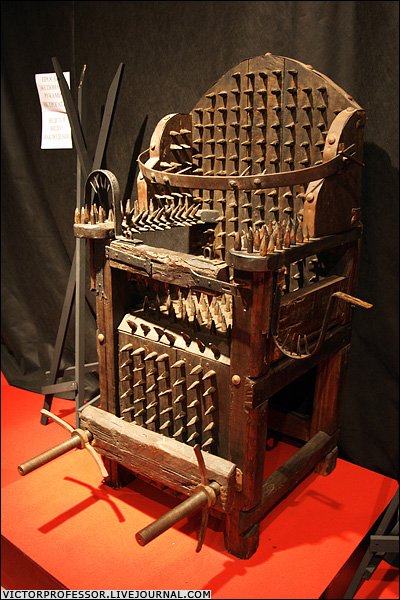Instruments of torture (24 photos)
1. Interrogation chair.
The interrogation chair was used in Central Europe. In Nuremberg and Fegensburg, until 1846, preliminary investigations using it were regularly carried out. The naked prisoner was seated on a chair in such a position that at the slightest movement, spikes pierced his skin. The torture usually lasted several hours, and the executioners often intensified the agony of the victim by piercing his limbs, using forceps or other instruments of torture. Such chairs had different shapes and sizes, but they were all equipped with spikes and means of immobilizing the victim.

2. Hand saw.
There is nothing to say about her, except that she caused death even worse than death at the stake. The weapon was operated by two men who sawed the condemned man suspended upside down with his legs tied to two supports. The very position itself, which caused blood flow to the brain, forced the victim to experience unheard-of torment for a long time. This instrument was used as punishment for various crimes, but was especially readily used against homosexuals and witches. It seems to us that this remedy was widely used by French judges in relation to witches who became pregnant by the “devil of nightmares” or even by Satan himself.

3. Throne.
This instrument was created as a pillory in the shape of a chair, and was sarcastically called the Throne. The victim was placed upside down, and her legs were strengthened with wooden blocks. This type of torture was popular among judges who wanted to follow the letter of the law. In fact, the laws governing torture only allowed the Throne to be used once during interrogation. But most judges circumvented this rule by simply calling the next session a continuation of the same first one.
Using the Tron allowed it to be declared as one session, even if it lasted 10 days. Since the use of the Throne did not leave permanent marks on the victim's body, it was very suitable for long-term use. It should be noted that at the same time as this torture, the prisoners were also “used” with water and a hot iron.

4. The janitor's daughter or Stork.
The use of the term "stork" is attributed to the Roman Court of the Holy Inquisition in the period from the second half of the 16th century. until about 1650. The same name was given to this instrument of torture by L.A. Muratori in his book “Italian Chronicles” (1749). The origin of the even stranger name "The Janitor's Daughter" is unknown, but it is given by analogy with the name of an identical device in the Tower of London. Whatever the origin of the name, this weapon is a magnificent example of the vast variety of coercive systems that were used during the Inquisition. The victim's position was carefully thought out. Within a few minutes, this body position led to severe muscle spasms in the abdomen and anus. Then the spasm began to spread to the chest, neck, arms and legs, becoming more and more painful, especially at the site of the initial occurrence of the spasm. After some time, the one tied to the Stork passed from a simple experience of torment to a state of complete madness. Often, while the victim was tormented in this terrible position, he was additionally tortured with a hot iron and other means. The iron bonds cut into the victim's flesh and caused gangrene and sometimes death.

5. Witch chair.
The Inquisition chair, known as the witch's chair, was highly valued as a good remedy against silent women accused of witchcraft. This common instrument was especially widely used by the Austrian Inquisition. The chairs were of various sizes and shapes, all equipped with spikes, with handcuffs, blocks for restraining the victim and, most often, with iron seats that could be heated if necessary. We found evidence of the use of this weapon for slow killing. In 1693, in the Austrian city of Gutenberg, Judge Wolf von Lampertisch led the trial of Maria Vukinetz, 57 years old, on charges of witchcraft. She was placed on the witch's chair for eleven days and nights, while the executioners burned her legs with a red-hot iron (insleplaster). Maria Vukinetz died under torture, going crazy from pain, but not confessing to the crime.

6. Common stake.
The technology of application is clear and without comment.

7. Suspension rack.
This is by far the most common cap, and was initially often used in legal proceedings, as it was considered an easy form of torture. The accused's hands were tied behind his back, and the other end of the rope was thrown through the winch ring. The victim was either left in this position, or the rope was pulled strongly and continuously. Often, additional weights were tied to the victim's notes, and the body was torn with tongs, such as a "witch spider", to make the torture less gentle. The judges thought that witches knew many ways of witchcraft, which allowed them to endure torture calmly, so it was not always possible to obtain a confession. We can refer to a series of trials in Munich in the early 17th century against eleven people. Six of them were constantly tortured with an iron boot, one of the women had her chest dismembered, the next five were wheeled, and one was impaled. They, in turn, reported on another twenty-one people, who were immediately interrogated in Tetenwang. Among the new accused was one very respectable family. The father died in prison, the mother, after being tried on the rack eleven times, confessed to everything she was accused of. The daughter, Agnes, twenty-one years old, stoically endured the ordeal on the rack with additional weight, but did not admit her guilt, and only said that she forgave her executioners and accusers. It was only after several days of continuous ordeal in the torture chamber that she was told of her mother's full confession. After attempting suicide, she confessed to all the terrible crimes, including cohabiting with the Devil from the age of eight, devouring the hearts of thirty people, participating in the Sabbath, causing Ouryu and renouncing the Lord. Mother and daughter were sentenced to be burned at the stake.

8. Vigil or Guarding the Cradle.
According to the inventor, Ippolito Marsili, the introduction of the Vigil was a turning point in the history of torture. The modern system of obtaining a confession does not involve the infliction of bodily harm. There are no broken vertebrae, twisted ankles, or shattered joints; the only substance that suffers is the victim's nerves. The idea of the torture was to keep the victim awake for as long as possible, a kind of insomnia torture. The "vigil", which was not initially considered a cruel torture, took various forms during the Inquisition, such as in the picture. The victim was raised to the top of the pyramid and then gradually lowered. The top of the pyramid was supposed to penetrate the area of the anus, testicles or coccyx, and if a woman was tortured, then the vagina. The pain was so severe that the accused often lost consciousness. If this happened, the procedure was delayed until the victim woke up. In Germany, “vigil torture” was called “cradle guarding.”

9. Dutch oven.
In the past, there was no Amnesty International association, no one intervened in the affairs of justice and did not protect those who fell into its clutches. The executioners were free to choose any, from their point of view, suitable means for obtaining confessions. They often also used a brazier. The victim was tied to bars and then "roasted" until genuine repentance and confession were obtained, which led to the discovery of more criminals. And life went on.

10. Torture with water.
In order to best carry out the procedure of this torture, the accused was placed on one of the types of racks or on a special large table with a rising middle part. After the victim's arms and legs were tied to the edges of the table, the executioner began work in one of several ways. One of these methods involved forcing the victim to swallow a large amount of water using a funnel, then hitting the distended and arched abdomen. Another form involved placing a cloth tube down the victim's throat through which water was slowly poured, causing the victim to swell and suffocate. If this was not enough, the tube was pulled out, causing internal damage, and then inserted again, and the process was repeated. Sometimes cold water torture was used. In this case, the accused lay naked on a table under a stream of ice water for hours. It is interesting to note that this type of torture was considered light, and confessions obtained in this way were accepted by the court as voluntary and given by the defendant without the use of torture.

11. Maid of Nuremberg.
The idea of mechanizing torture was born in Germany and nothing can be done about the fact that the Maid of Nuremberg has such origins. She got her name because of her resemblance to a Bavarian girl, and also because her prototype was created and first used in the dungeon of the secret court in Nuremberg. The accused was placed in a sarcophagus, where the body of the unfortunate man was pierced with sharp spikes, located so that none of the vital organs were affected, and the agony lasted for quite a long time. The first case of legal proceedings using the "Maiden" dates back to 1515. It was described in detail by Gustav Freytag in his book "bilder aus der deutschen vergangenheit". Punishment befell the perpetrator of the forgery, who suffered inside the sarcophagus for three days.

12. Wheeling.
A very popular system of both torture and execution was used only when accused of witchcraft. Typically the procedure was divided into two phases, both of which were quite painful. The first consisted of breaking most of the bones and joints with the help of a small wheel called a crushing wheel, equipped on the outside with many spikes. The second ball is designed in case of execution. It was assumed that the victim, broken and mutilated in this way, would literally, like a rope, slide between the spokes of a wheel onto a long pole, where he would remain to await death. A popular version of this execution combined wheeling and burning at the stake - in this case, death occurred quickly. The procedure was described in the materials of one of the trials in Tyrol. In 1614, a tramp named Wolfgang Zellweiser from Gastein, found guilty of intercourse with the devil and sending a storm, was sentenced by the court of Leinz to both be thrown on the wheel and burned at the stake.

13. Limb press.

14. Skull press.
This medieval device, it should be noted, was highly valued, especially in northern Germany. Its function was quite simple: the victim's chin was placed on a wooden or iron support, and the cap of the device was screwed onto the victim's head. First, the teeth and jaws were crushed, then, as the pressure increased, brain tissue began to flow out of the skull. Over time, this instrument lost its significance as a murder weapon and became widespread as an instrument of torture. In some Latin American countries, a very similar device is still used. Despite the fact that both the cover of the device and the lower support are lined with a soft material that does not leave any marks on the victim, the device brings the prisoner into a state of “readiness to cooperate” after just a few turns of the screw.

15. Impaling.
Impalement, one of the most cruel and barbaric methods of execution, is probably of Assyro-Babylonian origin. Common in the countries of the Middle East, execution was used during the wars of the Ottoman Empire with the infidels” against those convicted of illegally carrying weapons. The condemned were stripped naked and then placed on thin sharpened stakes. Exposed to the walls of the fortress, those executed died painfully, sometimes within several days. This was supposed to frighten the besieged. Impalement was especially widely used by Vlad Tepets (the famous Count Dracula), who executed thousands of Turks after his victory in the Battle of Wallachia.

16. Pillory.
The pillory has been a widespread method of punishment at all times and under any social system. The convicted person was placed in the pillory for a certain time, from several hours to several days. Bad weather during the punishment period aggravated the situation of the victim and increased the torment, which was probably considered as “divine retribution.” The pillory, on the one hand, could be considered a relatively mild method of punishment, in which the guilty were simply exposed in a public place to public ridicule. On the other hand, those chained to the pillory were completely defenseless before the “court of the people”: anyone could insult them with a word or action, spit at them or throw a stone - quiet treatment, the cause of which could be popular indignation or personal enmity, sometimes led to injury or even the death of the convicted person.

17. Violin of gossips.
It could be wooden or iron, for one or two women. It was an instrument of mild torture, with rather psychological and symbolic meaning. There is no documented evidence that the use of this device resulted in physical injury. It was applied mainly to those guilty of slander or insult to personality; the victim’s arms and neck were secured in small holes, so that the punished woman found herself in a prayer position. One can imagine the victim's suffering from poor circulation and pain in the elbows when the device was worn for a long period of time, sometimes for several days.

18. Prayer cross.
A brutal instrument used to restrain a criminal in a cross-like position. It is credible that the Cross was invented in Austria in the 16th and 17th centuries. This follows from the book “Justice in Old Times” from the collection of the Museum of Justice in Rottenburg ob der Tauber (Germany). A very similar model, which was located in the tower of a castle in Salzburg (Austria), is mentioned in one of the most detailed descriptions.

19. Rack.
This is one of the most common instruments of torture found in historical accounts. The rack was used throughout Europe. Usually this tool was a large table with or without legs, on which the convict was forced to lie down, and his legs and arms were fixed with wooden blocks. Thus immobilized, the victim was "stretched", causing him unbearable pain, often until the muscles were torn. The rotating drum for tensioning the chains was not used in all versions of the rack, but only in the most ingenious “modernized” models. The executioner could cut into the victim's muscles to speed up the final rupture of the tissue. The victim's body stretched more than 30 cm before exploding. Sometimes the victim was tied tightly to the rack to make it easier to use other methods of torture, such as pincers for pinching nipples and other sensitive parts of the body, cauterization with a hot iron, etc.

20. Rack.
Design element.

21. Garrote.
This execution weapon was used in Spain until recently. The last officially recorded execution using a garrote was carried out in 1975. The suicide bomber was seated on a chair with his hands tied behind his back, and an iron collar rigidly fixed the position of his head. During the execution process, the executioner tightened the screw, and the iron wedge slowly entered the skull of the condemned man, leading to his death. Another version, more common recently, is strangulation with a metal wire. This method of execution is often shown in feature films, especially espionage films.

22. Neck traps.
The weapons used by police officers and prison guards have specific functions - to exercise control and repression against unarmed prisoners. Of particular interest is the neck trap - a ring with nails on the inside and a device resembling a trap on the outside. Any prisoner who tried to hide in the crowd could be easily stopped using this device. After being caught by the neck, he could no longer free himself, and he was forced to follow the overseer without fear that he would resist. Such devices are still used in some countries, and in most cases they are equipped with an electroshock device.

23. Iron gag.
The instrument was used to stop the victim's shrill screams, which bothered the inquisitors and interfered with their conversation with each other. An iron tube inside the ring was tightly shoved into the victim's throat, and the collar was locked with a bolt at the back of the head. The hole allowed air to pass through, but if desired, it could be plugged with a finger and cause suffocation. This device was often used in relation to those sentenced to be burned at the stake, especially in the large public ceremony called Auto-da-Fé, when heretics were burned by the dozen. The iron gag made it possible to avoid a situation where convicts drown out spiritual music with their screams. Giordano Bruno, guilty of being too progressive, was burned in Rome in the Campo dei Fiori in 1600 with an iron gag in his mouth. The gag was equipped with two spikes, one of which, piercing the tongue, came out under the chin, and the second crushed the roof of the mouth.

24. Chest ripper. No comments.






















